国际贸易第二章19712
- 格式:ppt
- 大小:917.00 KB
- 文档页数:54
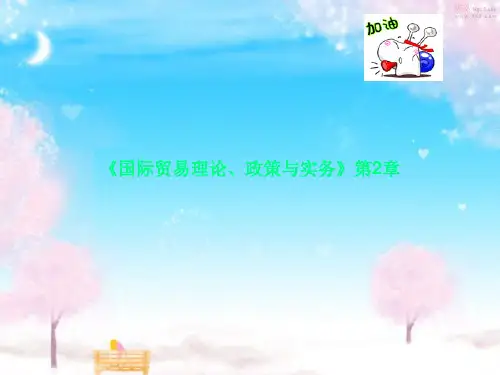
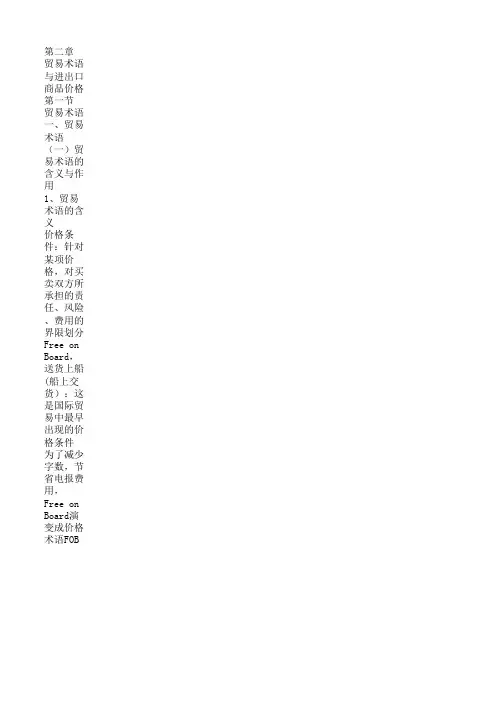
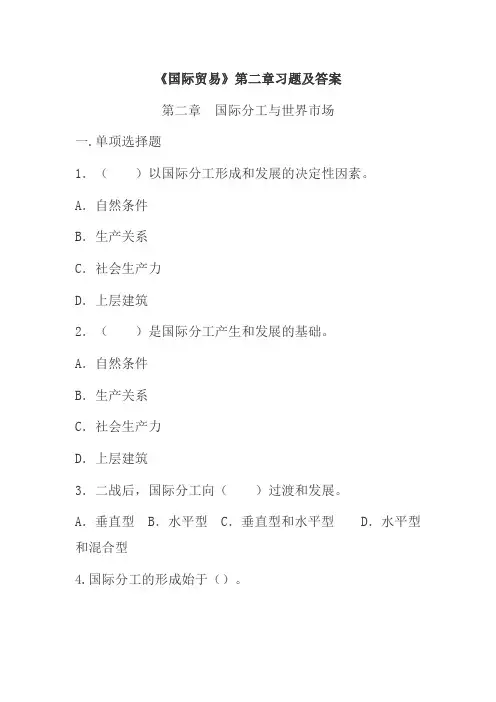
《国际贸易》第二章习题及答案第二章国际分工与世界市场一.单项选择题1.()以国际分工形成和发展的决定性因素。
A.自然条件B.生产关系C.社会生产力D.上层建筑2.()是国际分工产生和发展的基础。
A.自然条件B.生产关系C.社会生产力D.上层建筑3.二战后,国际分工向()过渡和发展。
A.垂直型B.水平型C.垂直型和水平型D.水平型和混合型4.国际分工的形成始于()。
A.第一次科技革命以后B.机器大工业建立以后C.第二次世界大战以后D.第一次世界大战以后5.世界自由市场价格形成的客观基础是()。
A.国际供求关系B.买卖双方的约定C.各国政府间的协商 D.各国资源的禀赋6.可以对国际分工起到推进或延缓双重作用的是()。
A.上层建筑B.资本流动C.社会生产力D.社会制度7.在资本主义原始积累时期,国际分工主要是在()之间进行的。
A.发达国家与发展中国家B.发达国家与发达国家C.发展中国家与发展中国家D.宗主国与殖民地8.单位商品的国际价值量的高低与劳动生产率成反比,与劳动强度()。
A.成反比B.相同C.成正比D.不相关9.宗主国与殖民地之间的分工最初出现于国际分工的()。
A.萌芽阶段B.形成阶段C.发展阶段D.深化阶段10.为国际分工的发展奠定了物质基础的是()。
A.国际资本的流动B.国际服务贸易的发展C.大机器工业的建立D.黄金二、多项选择题1.国际分工是()A.国际贸易的基础B.国际市场的基础C.国际贸易的产物D.国际市场的产物E.旧的国际经济秩序的重要组成部分2.影响国际分工形成与发展的因素包括()A.社会生产力B.社会生产关系C.自然条件D.资本流动 E.上层建筑3.对于生产力与国际分工的关系,下列说法中正确的有()A.生产力的发展决定了国际分工的产品内容B.各国生产力水平决定了其在国际分工中的地位C.生产力对于国际分工的形成起决定作用D.国际分工是生产力发展的必然结果4.对外贸易的乘数作用表现为()。
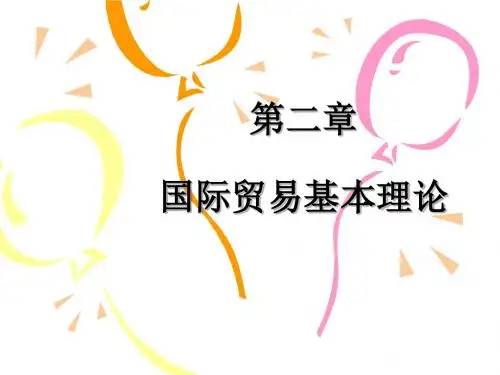
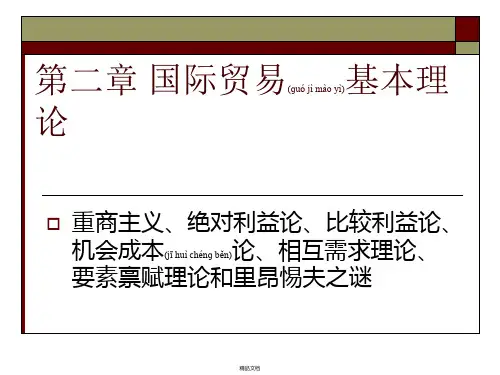

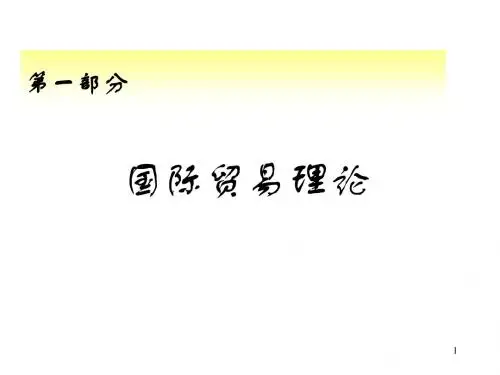
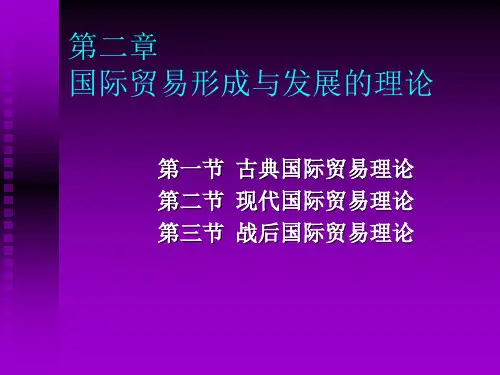
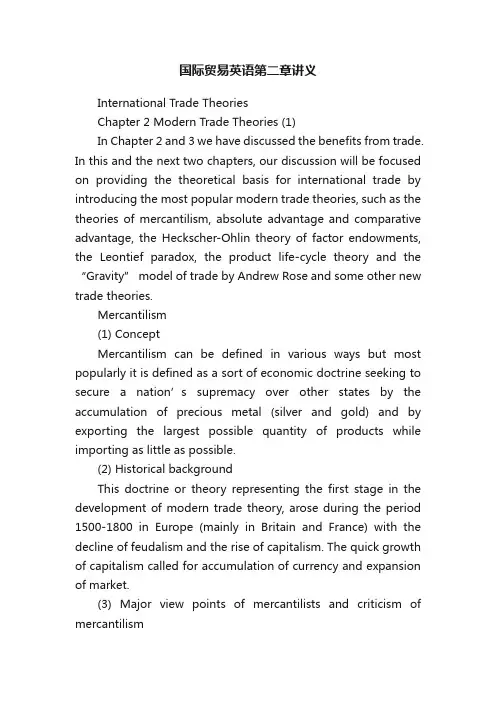
国际贸易英语第二章讲义International Trade TheoriesChapter 2 Modern Trade Theories (1)In Chapter 2 and 3 we have discussed the benefits from trade. In this and the next two chapters, our discussion will be focused on providing the theoretical basis for international trade by introducing the most popular modern trade theories, such as the theories of mercantilism, absolute advantage and comparative advantage, the Heckscher-Ohlin theory of factor endowments, the Leontief paradox, the product life-cycle theory and the “Gravity” model of trade by Andrew Rose and some other new trade theories.Mercantilism(1) ConceptMercantilism can be defined in various ways but most popularly it is defined as a sort of economic doctrine seeking to secure a nation’s supremacy over other states by the accumulation of precious metal (silver and gold) and by exporting the largest possible quantity of products while importing as little as possible.(2) Historical backgroundThis doctrine or theory representing the first stage in the development of modern trade theory, arose during the period 1500-1800 in Europe (mainly in Britain and France) with the decline of feudalism and the rise of capitalism. The quick growth of capitalism called for accumulation of currency and expansion of market.(3) Major view points of mercantilists and criticism of mercantilismAccording to the mercantilists like Thomos Mun (157-1641), the central question was how a country could regulate its domestic and international affairs so as to promote its own interests. The solution lay in a strong foreign trade sector. If a nation could achieve a favorable trade balance (trade surplus or a surplus of exports over imports), it would make a lot of money in the form of gold and silver. Such revenues would contribute to increased spending and a rise in domestic output and employment.To achieve a trade surplus the mercantilists like Thomos Mun advocated governmental regulation of trade. Tariffs, quotas and other commercial policies (even monopolization) were proposed by mercantilists to minimize imports in order to protect a nation’s trade position. In 1630, Thomos Mun —the mercantilist English writer was quoted as saying: “The ordinary means therefore to increase our wealth and treasure is by foreign trade, wherein we must observe the rule: to sell more to strangers yearly than we consume of theirs in value.”By the 18th century, the economic policies of the mercantilists were under strong attack. For example, David Hume expressed his disagreement with mercantilists by saying that a favorable trade balance was possible only in the short run, for over time it would automatically be eliminated. Adam Smith also opposed the theory of mercantilism with the theory of free trade and international division of labor.(4) Is mercantilism dead?The answer is no. It is still living and working in developed countries.Some trade experts say Japan is a neo-mercantilist nation because its government, while publicly supporting free trade,simultaneously seeks to protect certain segments of its economy from more efficient foreign competition. This example shows the theory of mercantilism remain in practice today. But modern version of mercantilism differs from the original in that today the accumulation of convertible currency instead of gold and silver is often the goal of governments.Absolute AdvantageThe second modern theory explaining why nations trade is Adam Smith’s absolute advantage. This theory of absolute advantage also represents the first stage in the development of modern trade theories.(1) DefinitionWhen country A can produce a unit of a good with less labor than countryB we say that country A has an absolute advantage in producing that good.(2) Major views of this theoryAdam Smith (1723-1790), one of the most influential classical economists was a leading advocate of free trade on the grounds that it promoted the international division of labor. According to his theory of absolute advantage, nations could concentrate their production on goods they could make most cheaply, with all the consequent benefits of the division of labor.In further explaining his principle of absolute advantage he used some suppositions. “In a two-country two-product world”, h e said, international trade and specialization will be beneficial when one country has an absolute cost advantage (that is, it can produce a good using fewer resources) in the production of one product, whereas the other country has about cost advantage in the other product. For nations to benefit fromthe international division of labor, each nation must have a kind of goods that it is absolutely more efficient in producing than its trading partner.Smith felt it was far better for a country to import goods that could be produced overseas more efficiently than to manufacture them itself. Countries would import goods in the production of which they had an absolute disadvantage against the exporting country. They would export goods in the production of which they had an absolute advantage over the importingcountry.More of his theory of absolute advantage can be found in his landmark book The wealth of Nations written in 1776 in which Adam Smith attacked the mercantilist assumption that trade was a zero-sum g ame. In Smith’s opinion each nation had some sort of absolute advantage in the production of certain goods. If it could specialize in the production of them and then exchange the goods with each other, every country would receive a benefit.(3) Illustration of the theory of absolute advantageSuppose there it’s a two-country, two-product world in which Ghana produces cocoa and South Korea rice. Assume that Ghana and South Korea both have 200 units of resources and that these resources can be used to produce either. Further imagine that in Ghana (due to its favorable climate, goods soil and ready access to world shipping routes) it takes 10 units of resources to produce one ton of cocoa and 20 units of resources to produce one ton of rice. Thus, Ghana could produce 20 tons of cocoa and no rice, 10 tons of rice and no cocoa, or some combination of rice and cocoa in between the two extremes.Similarly imagine that in South Korea it takes 40 units of resources to produce one ton of cocoa and 10 units of resourcesto produce one ton of rice. Thus, South Korea could produce 5 tons of cocoa and no rice, 20 tons of rice and no cocoa, or some combination between the two extremes. Clearly, Ghana has an absolute advantage in the production of cocoa and South Korea has an absolute advantage in the production of rice as shown in the following figure.So it is mutually beneficial for Ghana and South Korea to sell the product in the production of which they have absolute advantage.Comparative Advantage(1) DefinitionComparative advantage can be defined in the following two ways:a. According to the theory of comparative advantage, it makes sense for a country to specialize in the production of those goods it produces most efficiently and to buy the goods that it produces less efficiently from other countries, even if this means buying goods from other countries that it could produce more efficiently itself.b. A country has a comparative advantage in producing a good if the opportunity cost of producing that good in terms of other good is lower in that country than it is in other countries.(2) Chief points of viewIn explaining why nations trade, David Ricardo (1772-1823) developed the trade principle of comparative advantage. According to this principle, even if a nation has an absolute disadvantage in the production of both goods relative to its trading partner, a basis for mutually beneficial trade may still exist. The less efficient nation should specialize in and export the good in which it is comparatively less inefficient (where its absolutedisadvantage is least). The more efficient nation should specialize in and export that good in which it is comparatively more efficient (where its absolute advantage is greatest). Absolute productive efficiency was thus not a crucial factor governing the basis for international trade, according to Ricardo. The Ricardian model or principle of comparative advantage is today the most famous and influential principle of economics.(3) Illustration of the principle of comparative advantageThe operation of comparative advantage principle can be shown by thefollowing figure:Assume that Ghana is more efficient in the production of both cocoa and rice, that Ghana has an absolute advantage in the production of both goods. And that in Ghana it takes 10 units of resources to produce one ton of cocoa and units of resources to produce one ton of rice. Thus, given its 200 units of resources, Ghana can produce 20 tons of cocoa and no rice, 15 tons of rice and no cocoa, or any combination between on its PPF.In South Korea it takes 40 units of resources to produce one ton of cocoa and 20 units of resources to produce one ton of rice. Thus, South Korea can produce 5 tons of cocoa and no rice, 10 tons of rice and no cocoa or any combination on its PPF.Again assume that without trade each country uses half of its resources to produce rice and half to produce cocoa. Thus, without trade, Ghana will produce 10 tons of cocoa and 7.5 tons of rice, while South Korea will produce 2.5 tons of cocoa and 5 tons of rice. In light of Ghana’s absolute advantage in the production of both cocoa and rice why should it trade with South Korea? The answer is: Although Ghana has an absolute advantage in the production of both goods, it has comparativeadvantage only in the production of cocoa. In other words Ghana can produce 4 times as much cocoa as South Korea, but only 1.5 times as much rice. Ghana is comparatively more efficient at producing cocoa than it is at producing rice. In such a case when Ghana specializes in the production of cocoa and sell it in exchange for South Korea’s rice which it is more efficient at producing, there is still mutually beneficial trade.(4) Comparison between the theory of absolute advantage and the theory of comparative advantageAfter comparison we’ll find Ricardo’s theory of comparative advantage is more advanced than Smith’s theory of absolute advantage. According to Smith’s view, the product exported by a country must be a good which the exporting country has absolute advantage to produce and the cost of producing it must be absolutely lower than the same good of another country. But David Ricardo took Adam Smith’s theory of absolute advantage one step further. In his opinion not necessarily every country has to produce all sorts of goods. What a nation should do is to concentrate its efforts and resources on producing those goods high can generate more advantage and bring about less disadvantages. Under such conditions international trade would result in international division of labor and specialization beneficial to all countries. In addition, Ricardo particularly stressed labor productivity and argued that differences in labor productivity between nations underlie the notion of comparative advantage.Despite the differences between the two theories they have something in common. Both Smith and Ricardo emphasized the supply side of the market and the fact that the immediate basis for trade stemmed from cost differences. Actually Ricardo’stheory of comparative advantage was developed on the basis of Smith’s theory of absolute advantage.New Words1.doctrine 学说,理论2. feudalism 封建主义3. to regulate (依法)管理4. interests 利益(单数interest表示“利息”)5. to advocate 拥护,提倡6. to observe 遵守7. segment 部门 8.version 说法,看法9. convertible 可兑换的 10. to underlie 构成(理论、政策等)的基础11. monopolization 垄断Useful Phrases and Idiomatic Expressions1. to provide a basis for 为……提供根据2. to secure supremacy over sb. 获得超过某人的霸权3. to call for 要求,需要4. to contribute to 对……起一分作用5. to be quoted as saying“……” 被引述时这样说道“……”6. to consume of sth. 消费某物7. under strong attack 受到强有力的打击8. to express disagreement with sb. 表示对某人的不同意9. in the short run 在短期内(=in the short term)10. relative to 与……相比较11. in light of 按照,根据12. to take sth. One step further 比……高出一筹13. to concentrate sth. on sth. else 将某事集中于某事ExercisesI. Answer the following Questions:1. What is meant by the theory of absolute advantage?2. Can you give a good illustration of comparative advantage?3. Why is comparative-advantage theory more popular advantage?4. What is mercantilism? What are its main view points?5. In what way is the modern version of mercantilism different from the original one?6. What are the similarities and dissimilarities between the theory of absoluteadvantage and the theory of comparative advantage?II. Translate the following into English”1.李嘉图认为每个国家不一定要生产各种商品,而应集中力量生产那些利益较大或不利较小的商品然后通过国际贸易互相获益。
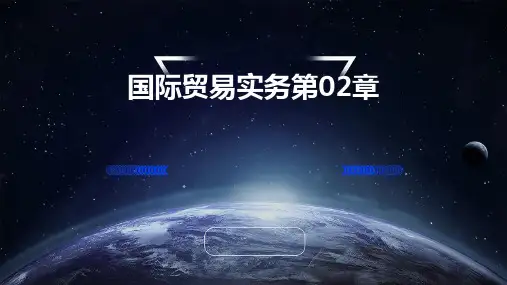
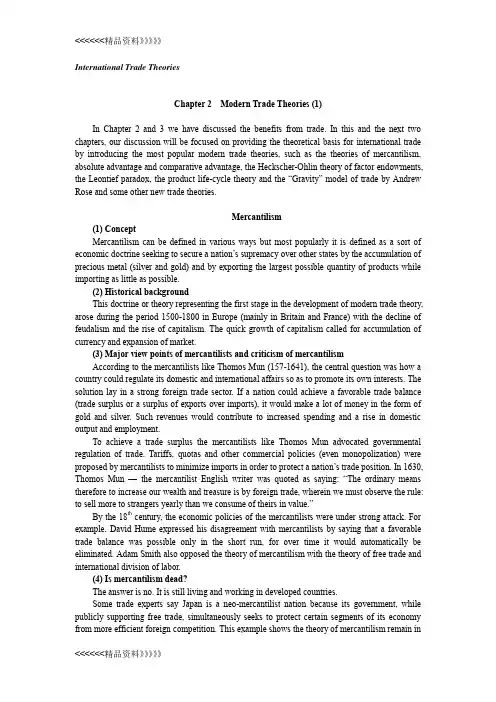
International Trade TheoriesChapter 2 Modern Trade Theories (1)In Chapter 2 and 3 we have discussed the benefits from trade. In this and the next two chapters, our discussion will be focused on providing the theoretical basis for international trade by introducing the most popular modern trade theories, such as the theories of mercantilism, absolute advantage and comparative advantage, the Heckscher-Ohlin theory of factor endowments, the Leontief paradox, the product life-cycle theory and the “Gravity” model of trade by Andrew Rose and some other new trade theories.Mercantilism(1) ConceptMercantilism can be defined in various ways but most popularly it is defined as a sort of economic doctrine seeking to secure a nation’s supremacy over other state s by the accumulation of precious metal (silver and gold) and by exporting the largest possible quantity of products while importing as little as possible.(2) Historical backgroundThis doctrine or theory representing the first stage in the development of modern trade theory, arose during the period 1500-1800 in Europe (mainly in Britain and France) with the decline of feudalism and the rise of capitalism. The quick growth of capitalism called for accumulation of currency and expansion of market.(3) Major view points of mercantilists and criticism of mercantilismAccording to the mercantilists like Thomos Mun (157-1641), the central question was how a country could regulate its domestic and international affairs so as to promote its own interests. The solution lay in a strong foreign trade sector. If a nation could achieve a favorable trade balance (trade surplus or a surplus of exports over imports), it would make a lot of money in the form of gold and silver. Such revenues would contribute to increased spending and a rise in domestic output and employment.To achieve a trade surplus the mercantilists like Thomos Mun advocated governmental regulation of trade. Tariffs, quotas and other commercial policies (even monopolization) were proposed by mercantilists to minimize imports in order to protect a nation’s trade position. In 1630, Thomos Mun —the mercantilist English writer was quoted as saying: “The ordinary means therefore to increase our wealth and treasure is by foreign trade, wherein we must observe the rule: to sell more to strangers yearly than we consume of theirs in value.”By the 18th century, the economic policies of the mercantilists were under strong attack. For example, David Hume expressed his disagreement with mercantilists by saying that a favorable trade balance was possible only in the short run, for over time it would automatically be eliminated. Adam Smith also opposed the theory of mercantilism with the theory of free trade and international division of labor.(4) Is mercantilism dead?The answer is no. It is still living and working in developed countries.Some trade experts say Japan is a neo-mercantilist nation because its government, while publicly supporting free trade, simultaneously seeks to protect certain segments of its economy from more efficient foreign competition. This example shows the theory of mercantilism remain inpractice today. But modern version of mercantilism differs from the original in that today the accumulation of convertible currency instead of gold and silver is often the goal of governments.Absolute AdvantageThe second modern theory explaining why nations trade is Adam Smith’s absolute advantage. This theory of absolute advantage also represents the first stage in the development of modern trade theories.(1) DefinitionWhen country A can produce a unit of a good with less labor than country B we say that country A has an absolute advantage in producing that good.(2) Major views of this theoryAdam Smith (1723-1790), one of the most influential classical economists was a leading advocate of free trade on the grounds that it promoted the international division of labor. According to his theory of absolute advantage, nations could concentrate their production on goods they could make most cheaply, with all the consequent benefits of the division of labor.In further explaining his principle of absolute advantage he used some suppositions. “In a two-country two-product world”, he said, international trade and specialization will be beneficial when one country has an absolute cost advantage (that is, it can produce a good using fewer resources) in the production of one product, whereas the other country has about cost advantage in the other product. For nations to benefit from the international division of labor, each nation must have a kind of goods that it is absolutely more efficient in producing than its trading partner.Smith felt it was far better for a country to import goods that could be produced overseas more efficiently than to manufacture them itself. Countries would import goods in the production of which they had an absolute disadvantage against the exporting country. They would export goods in the production of which they had an absolute advantage over the importing country.More of his theory of absolute advantage can be found in his landmark book The wealth of Nations written in 1776 in which Adam Smith attacked the mercantilist assumption that trade was a zero-sum game. In Smith’s opinion each nation had some sort of absolute advantage in the production of certain goods. If it could specialize in the production of them and then exchange the goods with each other, every country would receive a benefit.(3) Illustration of the theory of absolute advantageSuppose there it’s a two-country, two-product world in which Ghana produces cocoa and South Korea rice. Assume that Ghana and South Korea both have 200 units of resources and that these resources can be used to produce either. Further imagine that in Ghana (due to its favorable climate, goods soil and ready access to world shipping routes) it takes 10 units of resources to produce one ton of cocoa and 20 units of resources to produce one ton of rice. Thus, Ghana could produce 20 tons of cocoa and no rice, 10 tons of rice and no cocoa, or some combination of rice and cocoa in between the two extremes.Similarly imagine that in South Korea it takes 40 units of resources to produce one ton of cocoa and 10 units of resources to produce one ton of rice. Thus, South Korea could produce 5tons of cocoa and no rice, 20 tons of rice and no cocoa, or some combination between the two extremes. Clearly, Ghana has an absolute advantage in the production of cocoa and South Korea has an absolute advantage in the production of rice as shown in the following figure.So it is mutually beneficial for Ghana and South Korea to sell the product in the production of which they have absolute advantage.Comparative Advantage(1) DefinitionComparative advantage can be defined in the following two ways:a. According to the theory of comparative advantage, it makes sense for a country to specialize in the production of those goods it produces most efficiently and to buy the goods that it produces less efficiently from other countries, even if this means buying goods from other countries that it could produce more efficiently itself.b. A country has a comparative advantage in producing a good if the opportunity cost of producing that good in terms of other good is lower in that country than it is in other countries.(2) Chief points of viewIn explaining why nations trade, David Ricardo (1772-1823) developed the trade principle of comparative advantage. According to this principle, even if a nation has an absolute disadvantage in the production of both goods relative to its trading partner, a basis for mutually beneficial trade may still exist. The less efficient nation should specialize in and export the good in which it is comparatively less inefficient (where its absolute disadvantage is least). The more efficient nation should specialize in and export that good in which it is comparatively more efficient (where its absolute advantage is greatest). Absolute productive efficiency was thus not a crucial factor governing the basis for international trade, according to Ricardo. The Ricardian model or principle of comparative advantage is today the most famous and influential principle of economics.(3) Illustration of the principle of comparative advantageThe operation of comparative advantage principle can be shown by the following figure:Assume that Ghana is more efficient in the production of both cocoa and rice, that Ghana hasan absolute advantage in the production of both goods. And that in Ghana it takes 10 units of resources to produce one ton of cocoa and 3113 units of resources to produce one ton of rice. Thus, given its 200 units of resources, Ghana can produce 20 tons of cocoa and no rice, 15 tons of rice and no cocoa, or any combination between on its PPF.In South Korea ittakes 40 units of resources to produce one ton of cocoa and 20 units of resources to produce one ton of rice. Thus, South Korea can produce 5 tons of cocoa and no rice,10 tons of rice and no cocoa or any combination on its PPF.Again assume that without trade each country uses half of its resources to produce rice and half to produce cocoa. Thus, without trade, Ghana will produce 10 tons of cocoa and 7.5 tons of rice, while South Korea will produce 2.5 tons of cocoa and 5 tons of rice. In light of Ghana’s absolute advantage in the production of both cocoa and rice why should it trade with South Korea? The answer is: Although Ghana has an absolute advantage in the production of both goods, it has comparative advantage only in the production of cocoa. In other words Ghana can produce 4 times as much cocoa as South Korea, but only 1.5 times as much rice. Ghana is comparatively more efficient at producing cocoa than it is at producing rice. In such a case when Ghana specializes in the production of cocoa and sell it in exchange for South Kore a’s rice which it is more efficient at producing, there is still mutually beneficial trade.(4) Comparison between the theory of absolute advantage and the theory of comparative advantageAfter comparison we’ll find Ricardo’s theory of comparative advantag e is more advanced than Smith’s theory of absolute advantage. According to Smith’s view, the product exported by a country must be a good which the exporting country has absolute advantage to produce and the cost of producing it must be absolutely lower than the same good of another country. But David Ricardo took Adam Smith’s theory of absolute advantage one step further. In his opinion not necessarily every country has to produce all sorts of goods. What a nation should do is to concentrate its efforts and resources on producing those goods high can generate more advantage and bring about less disadvantages. Under such conditions international trade would result in international division of labor and specialization beneficial to all countries. In addition, Ricardo particularly stressed labor productivity and argued that differences in labor productivity between nations underlie the notion of comparative advantage.Despite the differences between the two theories they have something in common. Both Smith and Ricardo emphasized the supply side of the market and the fact that the immediate basis for trade stemmed from cost differences. Actually Ricardo’s theory of comparative advantage was developed on the basis of Smith’s theory of absolute advantage.New Words1.doctrine 学说,理论2. feudalism 封建主义3. to regulate (依法)管理4. interests 利益(单数interest表示“利息”)5. to advocate 拥护,提倡6. to observe 遵守7. segment 部门8.version 说法,看法9. convertible 可兑换的10. to underlie 构成(理论、政策等)的基础11. monopolization 垄断Useful Phrases and Idiomatic Expressions1. to provide a basis for 为……提供根据2. to secure supremacy over sb. 获得超过某人的霸权3. to call for 要求,需要4. to contribute to 对……起一分作用5. t o be quoted as saying“……” 被引述时这样说道“……”6. to consume of sth. 消费某物7. under strong attack 受到强有力的打击8. to express disagreement with sb. 表示对某人的不同意9. in the short run 在短期内(=in the short term)10. relative to 与……相比较11. in light of 按照,根据12. to take sth. One step further 比……高出一筹13. to concentrate sth. on sth. else 将某事集中于某事ExercisesI. Answer the following Questions:1. What is meant by the theory of absolute advantage?2. Can you give a good illustration of comparative advantage?3. Why is comparative-advantage theory more popular advantage?4. What is mercantilism? What are its main view points?5. In what way is the modern version of mercantilism different from the original one?6. What are the similarities and dissimilarities between the theory of absolute advantage and thetheory of comparative advantage?II. Translate the following into English”1.李嘉图认为每个国家不一定要生产各种商品,而应集中力量生产那些利益较大或不利较小的商品然后通过国际贸易互相获益。